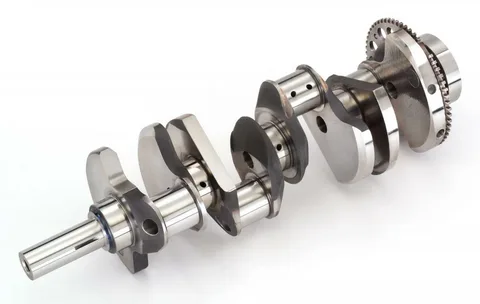
The Automotive Balance Shaft Market is projected to grow from its 2022 valuation of USD 14.03 billion to USD 25.01 billion by 2032, reflecting a CAGR of 6%. This growth is driven by increasing demand in the automobile sector for vehicles that produce less noise, harshness, and vibration, particularly those equipped with inline 4-cylinder engines, as well as the growing preference for fuel-efficient vehicles with low carbon emissions.
However, the market faces challenges due to the rising demand for luxury cars and SUVs powered by high-performance engines, along with the increasing popularity of electric vehicles. Despite these challenges, opportunities are anticipated to emerge as the demand for passenger vehicles rises in developing countries and new technologies are introduced.
The global automotive balance shaft market is analyzed across several geographical segments, including North America, Europe, Asia-Pacific, and Latin America and the Caribbean. In 2020, Asia and the Pacific accounted for more than half of the market share. However, the LAMEA (Latin America, Middle East, and Africa) region is expected to experience the fastest growth rate of 7.2% during the forecast period.
Original Equipment Manufacturers (OEMs) are increasingly using technologies to comply with pollution and fuel economy regulations, which has become a part of their branding strategies. In the U.S., new vehicles were required to achieve 34.1 mpg by 2016, equating to 250 g of CO2 per mile traveled. As consumers demand more fuel-efficient and low-emission vehicles, the automotive balance shaft market is growing. Additionally, the automotive industry’s expansion in developing countries further boosts this market, as balance shafts enhance engine performance.
Identify key trends, drivers, and challenges in the market, which will help vendors improve their strategies to stay ahead of their competitors. View our PDF Sample Report:
The affordability of auto-balancing shafts also contributes to market growth. Replacing a broken balancing shaft is relatively inexpensive, and their user-friendliness adds to their appeal; many consumers prefer purchasing new vehicles over repairing old ones. Increasing demand for passenger cars and light commercial vehicles, growing awareness about fuel efficiency and emission reduction, and stringent global emission regulations are key drivers of the automotive balance shaft market.
Despite these advantages, the market faces potential hindrances due to strict emission requirements and regulations imposed on vehicle manufacturers. Volatility in raw material prices may also slow market growth. Additionally, the rising demand for electric vehicles is projected to challenge the automotive balance shaft market in the coming years.
Key Takeaways
- Asia Pacific is the largest market for automotive balancing shafts, and the trend is likely to continue throughout the projection period due to its use in Japan, India, and China.
- The automotive balancing shaft industry is being propelled by tough laws enacted by governing authorities of several countries to reduce greenhouse gas (GHG) emissions from vehicles.
- The LAMEA market is expected to grow at the fastest rate throughout the forecast time frame, 7.2%.
- German vendors France, U.S., and UK are strengthening their footholds in fast-growing automotive balancing shaft industries while maintaining slow-growing positions.
Recent Developments
Seventeen new product lines were introduced by American Axle & Manufacturing, Inc. (AAM) in 2020. These new offerings ranged from vibration control systems with isolation pulleys and balance shaft modules to complete axles.
Competitive Landscape
SHW AG, Otics Corporation, Metaldyne LLC, Musashi Seimitsu Industry Co. Ltd., TFO Corporation, Sansera Engineering, Engine Power Components Inc., Ningbo Jingda Hardware Manufacture Co. Ltd., and others are just some of the major players in the automotive balance shaft market that PMR profiles in its report.
It’s no secret that many nations have set goals to reduce their carbon emissions, and this awareness has prompted vendors to come up with new and exciting product lines. To further expand their customer base, many companies in the automobile balance shaft sector are turning to mergers and partnerships.
Ready to Make an Informed Decision? Contact Sales Now!
Key Segments Profiled in the Automotive Balance Shaft Market Survey
Engine Type:
- Inline-3 Cylinder
- Inline-4 Cylinder
- Inline-5 Cylinder
- V-6 Cylinder
Manufacturing Process:
- Forged Balance Shaft
- Cast Balance Shaft
Application:
- Passenger Cars
- Light Commercial Vehicles
- High Commercial Vehicles
Region:
- North America
- Latin America
- Western Europe
- Eastern Europe
- APEJ
- Japan
- Middle East & Africa
About Future Market Insights (FMI)
Future Market Insights, Inc. (ESOMAR certified, recipient of the Stevie Award, and a member of the Greater New York Chamber of Commerce) offers profound insights into the driving factors that are boosting demand in the market. FMI stands as the leading global provider of market intelligence, advisory services, consulting, and events for the Packaging, Food and Beverage, Consumer Technology, Healthcare, Industrial, and Chemicals markets. With a vast team of 400 analysts worldwide, FMI provides global, regional, and local expertise on diverse domains and industry trends across more than 110 countries.
Contact Us:
Future Market Insights Inc.
Christiana Corporate, 200 Continental Drive,
Suite 401, Newark, Delaware – 19713, USA
T: +1-845-579-5705
For Sales Enquiries: sales@futuremarketinsights.com
Website: https://www.futuremarketinsights.com
LinkedIn| Twitter| Blogs | YouTube
